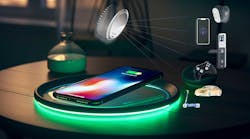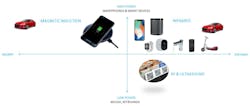Introduction to Wireless Power Technologies
Members can download this article in PDF format.
What you’ll learn:
- What is wireless charging?
- Key criteria and capabilities to wireless charging.
- Overview and comparison of the different technology approaches.
Wireless power technologies deliver electricity over the air to charge and power devices. In doing so, they provide freedom from power outlets, power cords, and battery replacements. They enable charger-free phones, completely wireless smart devices, drones that never need to land, and electric cars that charge seamlessly when parked or driven.
Wireless power makes it easier to install smart devices at home or in the office. For instance, a smart speaker can be placed anywhere without routing messy cords, and a smart lock can be charged wirelessly without worrying that the battery will ever run out of energy. Meanwhile, they offer superior power-hungry features like face recognition, which can thrive thanks to the availability of power.
This is true not just for smart locks, but for every battery-operated device. These devices trade performance and functionality for longer battery life. Smart features are power-hungry, which requires shortening the interval between charging or battery swaps. The tradeoff for battery-operated devices is inherent. A battery-operated security camera, for example, might be able to stream just one minute of video per day to preserve battery life. Wireless power removes that limitation.
Which devices can be powered without wires? Different devices have different power needs. Don't expect to disconnect your refrigerator or TV from the power outlet any time soon. But if you want to charge a phone from across the room, have wire-free surround speakers, smart-home devices, or game controllers that never die on you while you’re playing, the right wireless power technology can make this a reality.
Power Delivery
This article compares the benefits and shortcomings of the different wireless power technologies including radio frequency (RF), microwave (MW), magnetic induction, and infrared (IR), the four main approaches to delivering wireless power. All of them can be broadly termed “wireless power” or “wireless charging,” but each has very different sets of capabilities and user benefits.
Moreover, they don’t compete, but rather complement each other. A simple example is that magnetic induction (like the one used for charging pads) is a proximity charging technology while IR beaming aims at room-range charging.
Before we dive into comparing the merits of the different technologies, let’s establish common ground on a few important points to understanding wireless power and wireless power requirements:
- Wireless power is about delivering energy from point A to point B without having wires connecting those points. Thus, on side A, there’s a transmitting unit of some kind, while side B has a receiving unit of some kind. Power delivery needs both, just as Wi-Fi communication requires a router on one end and a receiving chip on the other end.
- Different devices have different power requirements (see table below). Charging an electric vehicle requires completely different power levels compared to a game controller, a laptop, or a smoke detector. While they all need power to operate, the quantity of power is an open question.
- Wireless power vs. wireless charging: The underlying technology in both cases can deliver energy from point A to point B without wires. That’s why it’s called “wireless.” Sometimes people use the term “charging” and other times they use the term “power.” In both cases, it refers to the exact same technology. The difference is whether the client device has an energy-storage device inside (such as a rechargeable battery or a supercapacitor) or is being directly powered without any built-in energy-storage device. The latter is rare for multiple valid reasons.
The Basic Merits of Wireless Charging
Each wireless power solution should be examined with respect to the following four merits:
- Range: What can the technology/solution support in terms of the maximum distance between the transmitter and receiver unit while maintaining the delivered power level?
- Power: How much power can be delivered safely and efficiently between point A and point B?
- Size of elements: As mentioned earlier, each wireless power solution is built from a “transmitter” unit and a “receiver” unit. The size of the receiver unit should be small enough to fit inside the client device (example: a 10- × 10-cm antenna on the receiver side can’t fit inside a smartphone or a smartwatch) and the size of the transmitter should be small enough to fit its environment. That said, when discussing outdoor applications and long-distance wireless transmission (miles), the size of the elements becomes less constraining.
- Safety: Every airborne transmission should comply with worldwide safety regulations assuring that humans and pets aren’t exposed to unnecessary EM radiation, and that the stray radiation doesn’t interfere with or block the operation of other devices, such as jamming a Wi-Fi router or a pilot’s navigation system.
Examining the limitations of each of these criteria can be a lengthy exercise. For simplicity’s sake, let’s focus on the relationship between range and size of elements (see figure). This is a figure of merit that’s determined by physics (diffraction) and is relevant to all wireless power technologies.
This criterion ties the size of the element to the distance, assuming all (or close to) 100% of the transmitted power reaches the receiving end. Failing to do so will dramatically reduce the system’s efficiency and pollute the environment with unnecessary stray radiation. The latter would not be allowed by the different regulatory agencies (e.g., FCC, FDA, UL, and so on).
One exception to the above: For ultra-low-power applications such as basic sensors, the stray radiation can be below the FCC threshold for ambient radiation and, in this case, such solutions are legitimate and of value. They will be limited to very low power, and we address them as power harvesting rather than power beaming because they collect a very small portion of the transmitted energy.
In some cases, a transmitter isn’t needed. These devices operate on ambient stray radiation from wireless communication, electricity wires, transformers, and the like.
Considering diffraction and coupling efficiency, let’s review the different technologies’ capabilities:
Magnetic induction
This is the technology we all know from wireless charging pads. It’s based on magnetic induction between a coil in the pad, or “transmitter,” and a coupled coil in the device, or “receiver.” The distance is limited to a few centimeters at best. However, it can generate high enough power levels to charge even kitchen appliances.
Magnetic resonance
This technology represents an improvement over magnetic induction, allowing for some distance between the receiver and transmitter. However, the rule of thumb is that the distance between the charging station and client device is roughly the size of the charging coil. This means if one would like to charge a device that’s 1 m/3 ft away, the coil diameter should be roughly the same order of magnitude. Magnetic resonance works well with large devices and is capable of enough power to charge an electric vehicle parked above a magnetic charging pad.
Both magnetic induction and magnetic resonance work best when the two coils are parallel to each other and directly one above the other. Failure to align would dramatically impact efficiency. This can be overcome by adding more and more coils, one next to the other.
RF beaming
Due to the long wavelength of RF/MW (2.4 GHz is roughly 10 cm in wavelength and 24 GHz is 1 cm in wavelength) compared to devices’ dimensions, these solutions suffer from fast divergence of the transmitted beam. It limits the solutions to either short distances or very large transmitter and receiver units. The underlying limitation is that while the beam spreads fast, the receiver size is given and can’t capture the radiation that “missed” it.
- When powering ultra-low-power devices, this limitation is removed. As a result, devices are able to capture only tiny fractions of the transmitted power, which has a positive upside. Under these conditions, the transmitter and receiver units don’t require line of sight between them, providing more freedom to charge devices in complicated scenarios.
- Unless using large elements compared to the charging wavelength, the client power for RF charging drops at a rate of one over distance squared as the distance increases between the transmitter and receiver.
Infrared charging
Thanks to its very short wavelengths, infrared can remain focused for long distances. Thus, a safe and powerful beam can be delivered across tens of meters while maintaining receivers that are small enough to fit inside devices like a smartwatch. The technology is limited to line-of-sight charging. Alignment between transmitter and receiver isn’t important and power doesn’t drop over distance.
Summary
Different technologies capable of charging devices wirelessly exist and complement each other to support the different use cases. Magnetic induction in the form of charging pads is the one we know best, with such pads having been deployed over the last decade. While limited to proximity charging, it’s capable of charging devices with low or high-power requirements.
RF and microwave distance charging will most likely be limited to use cases of powering ultra-low-power devices, but it offers non-line-of-sight charging. Though this will be applicable to different types of sensors, it will not be able to charge consumer devices due to the inability to deliver high power to small receivers at the same time.
Infrared wireless charging, which is the first to be commercialized and deployed worldwide as of the end of 2022, is the most promising. It delivers high power over long range and can thus support a wide array of consumer electronics devices. This technology is already deployed primarily in the retail market, powering devices from 30 feet away and slowly moving into consumers’ homes.
After a long wait of a decade or more, two different technologies now have made a huge step toward the goal of a wireless power future.


